Henry Ford was one of the few early automotive pioneers who understood that standardization was a way to reduce costs across the board. His most famous feat in this regard was painting every Model T black for a period as this would get more cars through the assembly line in the same amount of time. Yet, as time wore on, even Ford had to offer a multitude of options to placate customers. One of the more unusual was a smaller version of the famous Flathead V-8 called the V8-60. If you want to try out one of these oddities, then check out this 1937 Ford coupe for sale on eBay in Salt Lake City, Utah. Highly original and still packing this diminutive V-8, is this presentable coupe worth more than the current $10,500 bid? If you bought it, would a heart transplant be in order to get this coupe moving again?
During the Depression, competition among the three top economy brands of Ford, Chevrolet, and Plymouth was fierce. If you look at the specifications of all three, you will note that price, horsepower, weight, and wheelbase are all very close throughout the thirties between all of what was called “the low-priced three.” One of the ways they kept costs down was a standardization of mechanical parts from the drivetrain to the smaller parts and pieces that make up a car. The one hole in this was that Ford would go off on a tangent making unusual body styles that didn’t sell well. When you take a deep dive into how Ford was being run at the time, some of these inconsistencies are easy to understand.
While the company was so vast and complicated that no one person could have effectively controlled it all, the size of the organization allowed far-flung subsidiaries like Ford’s European operations to practice some autonomy. Ford in Great Britain used that autonomy to produce a reduced-sized Flathead V-8 to adapt to Great Britain’s insane power output taxes. The initial version of this engine was designed in Dearborn, Michigan, and had numerous teething issues. The second version worked much better and soon found a home in Fords sold in England and France.
The engine turned out so well that it was offered in lower-end Fords in the United States starting in 1937 as an economic option. While it produced acceptable horsepower numbers hovering around 60 HP when the standard Flathead belted out 85 HP, the torque ratings were dreadful. Customers liked the fuel economy but absolutely hated the lackadaisical acceleration that the little engine couldn’t seem to produce in anything that approached a hurry. Initial sales were brisk until word got out of just how slow the V8-60-powered cars were. While it was offered until 1940 in the United States, the option wasn’t chosen very much. The engine did survive until after the war in Europe, where it made more sense given their situation.
One place that the V8-60 proved its worth was on the racetrack. In the racing classes that limited overall displacement, such as Midget racers, the V8-60 was a force to be reckoned with. They were also plentiful, as many owners swapped the smaller engines for standard-size Flatheads when they could. Today it is hard to find an American Ford of this era with the smaller V-8 still under the hood. The Early Ford V-8 Club of America produces an outstanding magazine that occasionally has an article about these engines and the cars they powered. One of those stories was an account of a gentleman who restored a V8-60 powered car and drove it across a great distance to a meet. He made it over the Rockies, but the overall experience required a tremendous amount of patience.
The car you see is an original V8-60 powered 1937 Ford coupe that was discovered in a barn in 1996. It sat on jackstands until 2016 when it was treated to a mild restoration that apparently focused on keeping as much of the original condition material as possible. The fuel system was gone through, and the gas tank has been replaced. It is unclear if the car still has mechanical brakes or if there has been a hydraulic upgrade. Regardless, everything on the car functions as it should, and it recently finished a leisurely trip down Route 66 from Chicago to Santa Monica, California. It isn’t a perfect car, but it is perfect for someone who wants a prewar Ford coupe that is ready to go at a moment’s notice. Hopefully, it finds a good home with someone who will use it frequently.
Would you keep this Ford’s original powerplant, or would you swap in a period correct full-size Flathead? Please share your thoughts in the comments.
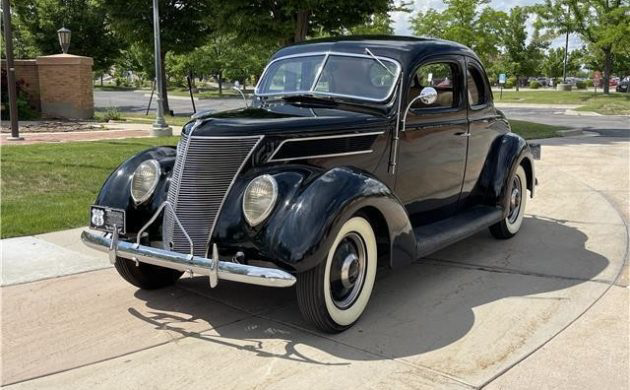
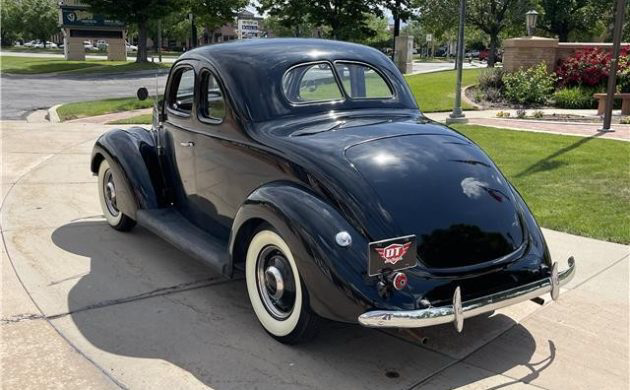
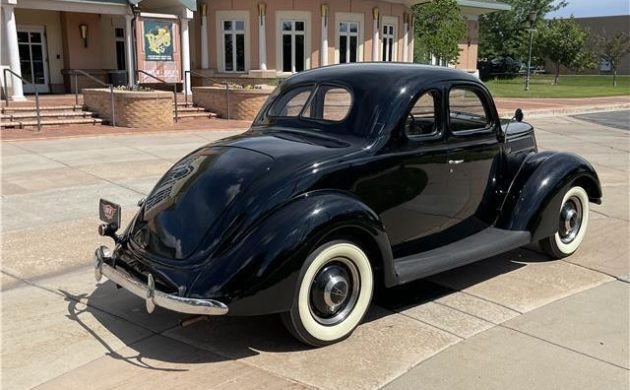
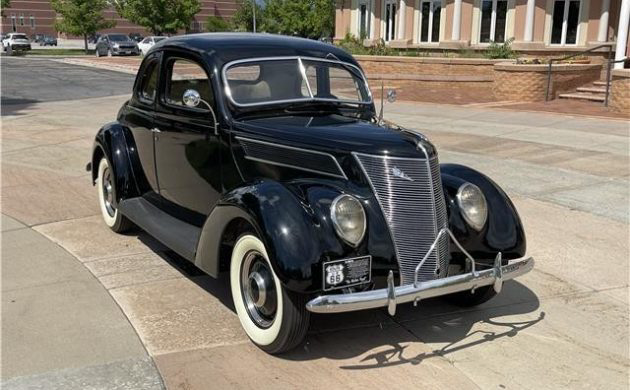
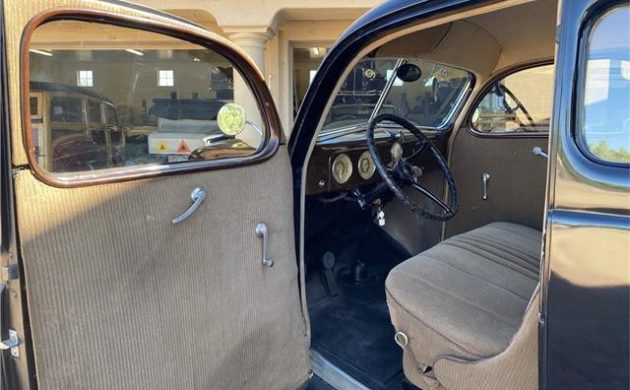
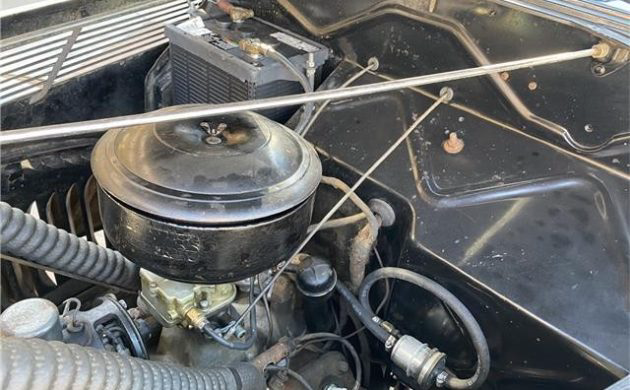


As nice as it gets. Needs to be in the Don Garlits museum in Ocala, Florida. If I had it I’d want to drive it which would entail an engine change to a full size, modified flat head. Then, put the 80 on a pedestal in your custom garage or den to show folks Ford history.
Anyone who knows anything about the V-8 60, will tell you they won’t pull a sick ***re off a p*** pot.
Good response, I had an instructor in trade school that said that all the time, you are the only one besides him that I have heard say that.
Classy.
Drop in a 50’s Merc 100 GP flatter upgrade the brakes and tires and drive it
Yep, sounds good to me. (No bellybutton sbc or ls)
Merc 100 HP flattie dang fat fingers don’t work well on I phone
LOL
Anybody planning a swap out to a 85 hp or larger flattie better check out the final drive ratio, My ’37 had a 4.44 rear end that ultimately destroyed the ’41 engine I put in her.
keep it, whadda ya usin it 4 anyway~
At 136cubes its gotta B the smallest bent8
Pretty stroked at 2 1/2 by 3 1/4 inch bore ta stroke.
About .48 HP per cube BUT revs peaked about 4K only
produced top tq (100) at abt 2500 RPMs. Their standard i4
(since model “T” daze) got 128. The motor was for the Depression
Era gas prices & GB/the Continent (motor taxed on power) sales markets.
Better intake (TBI?) and valves, (modern cam is out), may be more mains ora girdle (sompin) and small turbo (low pressure) ? offset grind crank for even more stroke? What did the 40/50’s midget and boat racers do besides nitro? I hear there were lots of after mrkt speedy bits back then…
Is that the engine that the V8 Pilot used? Maybe some post-war Simcas, too.
It’s a nice car.
Tim I appreciate the older and classic car I would leave it all stock I have a 51 custom someone put a chevy in it u can guess what I did.
Gotta keep it as is for the novelty of it. There aren’t many original examples left of a truly original piece of Ford history. Sure it was slow, and underpowered, that’s what makes this one unique. It is as it was, and it needs to stay that way.
I owe you an apology, Mark. I intended to endorse your comment (which I later did) but instead selected the Report Comment function. Sorry!
This site is pretty lame . You list a car then give zero information on how to contact seller lame ..IL be unsurprising quick ..
What are you talking about? All the info is right in the first paragraph. How much simpler could we make it?
Only one taillight on the car and he STILL put the blue dot in it.
I agree with Mark: keep it as it is (except, remove that blue dot!) — and drive it as Ford intended. That is what I would do with it. Not for climbing mountains or blazing along the Interstate, obviously!. But, with the price of gasoline these days, this diminutive powerplant in an old Ford with one tail-light might be appreciated. Hope you know how to do hand-signals! (But, does anybody understand those any more?)
I remember my father telling me those cars were so underpowered that it couldn’t climb the hills in San Francisco!
To chrisful: could you PLEASE dispense with all the abbrevs., and SPELL YOUR WORDS OUT? Thank you! Otherwise… why no PRICE on this car???
It’s mostly “original”. V-8 60s were all standard models and should have a black grill and body color windshield frame.
As for an engine swap, be advised that the 60 had a thinner, lighter frame.
These yr Fords were the best style IMO. What would I do about the engine? Dunno, but seems to me if you’re just going to take it to local car drive ins and what not, that one would do fine. It’s all what you want to spend and have available. For sure, no SBC. A souped up Merc flattie would be awesome.
In comparison to the Margaret Who vehicle, this car has real value and is a much preferred model. Still not worthy of $100k price tag.